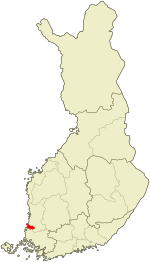Rauma dialect ("rauman giäl", "language of Rauma") is a Southwestern dialect of Finnish spoken in the town of Rauma, Finland.
The written form of the dialect was preserved by the writer and doctor Hj. Nortamo, and is currently practiced mainly as a hobby. Some of the most distinctive characteristics of the dialect (as written) are the use of letters 'g' and 'b', which are uncommon in the Finnish language. Pronunciation of these letters is, however, is in between 'g' and 'b' and 'k' and 'p' of mainstream Finnish. And the shortening of words.[1] The Rauma dialect also contains its own pitch accent.[2]
History
Rauma is only spoken in a very small area of Finland, the Rauma dialect was not influenced by the Tavastian dialects unlike its neighbours, but instead Rauma was influenced by other languages such as Swedish. During the 19th century Rauma was one of the most active sea ports and during that time most Rauma people were working in the sea, which caused them to take words and influence from all over Europe. When the written language of Finnish was created, it was strictly banned to write in Finnish dialects. However it was changed when the writer Hj.Nortamo started writing in Rauma. [3]
Recently, there have been some dictionaries released for the Rauma dialect[4]
Rauma used to have the sound /θ/ and it was even heard at the end of the 20th century. Rauma also had a sound /ð/, however now even in Rauma a sound /r/ has been replacing it.[5]
Examples with Finnish and English translations
- "San snää mnuu snuuks, snuuks mnääki snuu sno."
- Finnish: Sano sinä minua sinuksi, sinuksi minäkin sinua sanon.
- Spoken Finnish of Helsinki area: Sano säki mua suks, suks mäki sua sanon.
- English: "You should call me 'thou', as I will call you 'thou' too." (Used when dropping titles and starting to use first names.)
- "Ol niingon gotonas"
- Finnish: Ole kuin kotonasi.
- Spoken Finnish of Helsinki area: Oo niinku kotonas.
- English: "Make yourself at home."
- "Luanikast reissu"
- Finnish: Hyvää matkaa.
- Spoken Finnish of Helsinki area: Hyvää matkaa.
- English: "Have a nice journey."
- "Mnää on Raumalt, mist snää ot?"
- Finnish: Minä olen Raumalta, mistä sinä olet?
- Spoken Finnish of Helsinki area: Mä oon Raumalt(a), mist(ä) sä oot?
- English: "I am from Rauma, where are you from?"
- "Mimne baat snuul o?"
- Finnish: Minkälainen vene sinulla on?
- Spoken Finnish of Helsinki area: Millane botski sul o?
- English: "What kind of a boat do you have?"
Features
Shorter words
ihmettlevä 'they wonder' (Finnish: ihmettelevät)
Shorter vowels
totus 'truth' (Finnish: totuus 'truth')
k, t and p before a nasal consonant.
t becomes d, k becomes g, and p becomes b before a nasal consonant.
tliin dännekkin gattlema 'I also come here to see'
Diphthongs
yö, ie, and uo became: yä, iä and ua.
diphthongs that end in u, y and i have changed into o, ö and e, if the next syllable does not start with: d, r, l, h or v.
kööh 'poor' (Finnish 'köyhä')
Final -t
the ending -t is gone in the Rauma dialect, but it is replaced by: k, t, p, s or f, if the next word is followed by those letters.
poja oliva ilossi 'the boys were happy'.
flikat tahtosivaf fölihi 'the girls wanted into their company'
Plural genetive
In the Rauma dialect, the plural genetive is marked by -tte.[6]
References
- ^ Archived at Ghostarchive and the Wayback Machine: RAUMAN GIÄLEN GOUL 1. YouTube.
- ^ "Eurajoen murrepiirteitä". Kotimaisten kielten keskus (in Finnish). Retrieved 2021-05-29.
- ^ "Raumalaisten erikoinen "giäl"". yle.fi (in Finnish). Retrieved 2021-01-31.
- ^ "Uusi "sanakiri" auttaa ymmärtämään raumalaisia". Helsingin Sanomat (in Finnish). 1992-12-23. Retrieved 2021-01-31.
- ^ "Eurajoen murrepiirteitä". Kotimaisten kielten keskus (in Finnish). Retrieved 2021-05-29.
- ^ "rauman kieli". www.nortamo-seor.fi. Retrieved 2021-05-26.
External links
- Uusi Rauma, a newspaper which publishes a complete issue in Rauma dialect once a year and publishes weekly columns in Rauma dialect. Back issues with Rauma dialect
- Nortamo seor
- Music in Rauma

